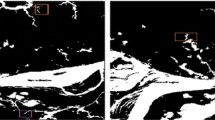Abstract
Identifying locations of protein expression in live cells plays an important role in several medical applications ranging from early disease diagnosis to monitoring effectiveness of drugs. Protein localization is directly related to their cell types. Today florescence imaging is widely used to understand biology at the cellular level. Hence, cell phenotype classification in fluorescence microscope images, is related with protein localization. Today it is performed by human, which is very time consuming with low accuracy. According to the visual structure, it can be seen that samples of a unique cell type have quite similar texture, but the texture of different cell types, are very different. In this respect, texture information can be used more widely than shape or color information, to classify types. Local ternary pattern is a noise-resistant texture descriptor that provides discriminative features. In this paper a local texture analysis descriptor is proposed titled multi threshold uniform-based local ternary patterns with notation MT-ULTP. MT-ULTP extracts local significant texture information in different locality levels. In this respect, local ternary patterns are extracted in different thresholds and finally the occurrence probability of the uniform patterns is extracted as features. MT-ULTP is a skillful combination of LTP and MLBP with novelty in feature extracting and local pattern selecting. Performance of the proposed descriptor is evaluated on 2d-hela dataset in terms of accuracy. 2d-hela is the benchmark dataset of cell phenotype images. Experimental results show that MT-ULTP provides higher classification rates than very well-known texture descriptors such as lbp-like descriptors. In other experiments, it has been shown that ignoring uniform textural patterns in the image analysis can increase the accuracy of cell phenotype classification and some other computer vision-based applications. The results also showed that extraction uniform patterns based on a combination of thresholds provide better results than the simple form in local ternary patterns. The proposed image texture descriptor is a general case which can be used in many computer vision applications to describe the image contents.



Similar content being viewed by others
References
2D hela dataset, http://murphylab.web.cmu.edu/data/2Dhela_images_download.html, accessed 25 November 2019.
Boland MV, Murphy RF (2001) A neural network classifier capable of recognizing the patterns of all major subcellular structures in fluorescence microscope images of hela cells. Bioinformatics 17(12):1213–1223
Fekri-Ershad S (2019) Pap smear classification using combination of global significant value, texture statistical features and time series features. Multimed Tools Appl 78(22):31121–31136
Fekriershad S, Tajeripour F (2017) Color texture classification based on proposed impulse-noise resistant color local binary patterns and significant points selection algorithm. Sens Rev 37(1):33–42
Lazebnik S, Schmid C, Ponce J (2006) Beyond bags of features: Spatial pyramid matching for recognizing natural scene categories. In Proc. of IEEE Computer Society Conference on computer vision and pattern recognition 2:2169–2178
Lin D, Lin Z, Sun L, Toh K, Cao J (2017) LLC encoded bow features and softmax regression for microscopic image classification. In Proc. of IEEE International Symposium on Circuits and Systems
Liu D, Wang S, Huang D, Deng G, Zeng F, Chen H (2016) Medical image classification using spatial adjacent histogram based on adaptive local binary patterns. Comput Biol Med 72:185–200
Murphy R, Velliste M, Porreca G (2002) Robust classification of subcellular location patterns in fluorescence microscope images. In Proc. of IEEE International workshop on neural networks for signal processing. 67–76
Nani L, Lumini A, Lin Y, Hsu C, Lin C (2010) Fusion of systems for automated cell phenotype image classification. Expert Syst Appl 37:1556–1562
Nanni L, Brahnam S, Lumini A (2010) Novel features for automated cell phenotype image classification. Adv Exp Med Biol 680:207–213
Nanni L, Lumini A, Brahnam S (2012) Survey on LBP based texture descriptors for image classification. Expert Syst Appl 39:3634–3641
Nguyen L, Lin D, Lin Z, Cao J (2018) Deep CNNs for microscopic image classification by exploiting transfer learning and feature concatenation. In Proc. of IEEE International Symposium on Circuits and Systems
Ojala T, Pietikainen M, Maenpaa T (2002) Multiresolution gray-scale and rotation invariant texture classification with local binary patterns. IEEE Trans Pattern Anal Mach Intell 24(7):971–987
Pietikäinen M, Ojala T, Xu Z (2000) Rotation invariant texture classification using feature distributions. Pattern Recogn 33:43–52
Quan Q, He F, Li H (2020) A multi-phase blending method with incremental intensity for training detection networks. The Visual Compute, online, https://doi.org/10.1007/s00371-020-01796-7
Ren J, Jiang X, Yuan J (2013) Noise-resistant local binary patterns with an embedded error-correction mechanism. IEEE Transaction on Image Processing 22(10):4049–4060
Su X, Liu S, Qiao X, Yang Y, Song K, Kong B (2015) Pattern recognition cytometry for label-free cell classification by 2d ligh scattering measurements. Optics Express 23(21)
Tajeripour F, Kabir E, Sheikhi A (2008) Fabric defect detection using modified local binary pattern. EURASIP Journal on Advances in Signal Processing 08:1–12
Tan X, Triggs B (2010) Enhanced local texture feature set for face recognition under different lighting conditions. IEEE Transaction on Image Processing 19(6):1635–1650
Wu Y, He F, Zhang D, Li X (2018) Service-oriented feature-based data exchange for cloud-based design and manufacturing. IEEE Transactions on Services Computing 11(2):341–353
Yu H, He F, Pan Y (2020) A scalable region-based level set method using adaptive bilateral filter for noisy image segmentation. Multimed Tools Appl 79:5743–5765
Zhang XQ, Zhao S (2020) Fluorescence microscopy image classification of 2D HeLa cells based on the CapsNet neural network. Medical & Biological Engineering & Computing 6:1187–1198
Zhang J, He F, Chen Y (2020) A new haze removal approach for sky/river alike scenes based on external and internal clues. Multimed Tools Appl 79:2085–2107
Author information
Authors and Affiliations
Corresponding author
Additional information
Publisher’s note
Springer Nature remains neutral with regard to jurisdictional claims in published maps and institutional affiliations.
Rights and permissions
About this article
Cite this article
Fekri-Ershad, S. Cell phenotype classification using multi threshold uniform local ternary patterns in fluorescence microscope images. Multimed Tools Appl 80, 12103–12116 (2021). https://doi.org/10.1007/s11042-020-10321-w
Received:
Revised:
Accepted:
Published:
Issue Date:
DOI: https://doi.org/10.1007/s11042-020-10321-w




